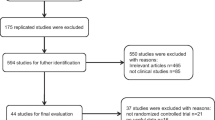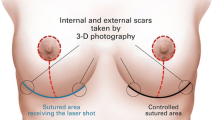Abstract
The aim of this study was to compare the effects of the pulsed-dye laser (PDL) at a wavelength of 585 nm with those at 595 nm in the treatment of post-surgical scars, starting on the day of suture removal. The study was a prospective, non-randomized, double-blind, controlled, clinical trial, set in an outpatient clinic. Fifteen outpatients with 21 post-operative scars at least 3 cm long were recruited, and 14 patients with 19 scars completed the study. Scars were divided into three equal portions. Each outer portion was randomly allocated to PDL at 585 nm or at 595 nm (3.5 J/cm2, 450 μs, 10 mm spot size), and the center was an untreated control; treatment was composed of three laser sessions at 4-week intervals. A blinded examiner evaluated the three scar sections using the Vancouver scar scale for pigmentation, vascularity, pliability, and height. Cosmetic appearance was evaluated with a visual analog scale. Punch biopsies of three randomly selected scars were evaluated. Pigmentation: more scars after laser treatments were of normal color than in the control, but the difference was not statistically significant. Vascularity: after treatment, more scars had normal vascularity in all three groups than at baseline (P < 0.05); the largest increase was with a wavelength of 585 nm (10.5–94.7%), then 595 nm (15.8–78.9%), then control (5.2–36.6%). Pliability: there was more normal pliability in all three groups than at baseline (P < 0.05), with greater improvements in the laser-treated groups. Height: significantly more flat scars after 585 nm PDL (63.2%) than at baseline (21.1%) (P < 0.05). We observed a slight but non-significant decrease in the scar heights with 595 nm PDL in comparison with the control. Histology: after laser irradiation, the treated sections were more similar to a non-scarring process than the control. Cosmetic outcome: visual analog scales increased in all groups (P < 0.05), but the greatest increases were observed in the 585 nm and 595 nm laser-treated groups (50% and 60%, respectively) compared with controls (30%). There were significantly higher scores with the lasers than for the control (P < 0.001) at each visit after baseline. Both the 585 nm and 595 nm PDL treatments were effective in improving the appearance and normalizing the vascularity and pliability of post-operative scars. Both wavelengths improved the scars’ visual appearance more than controls. We found that 585 nm appears to be the preferred wavelength, as it substantially normalized the height in addition to the vascularity and pliability in a significant number of scars.










Similar content being viewed by others
References
Alster TS (1994) Improvement of erythematous and hypertrophic scars by the 585 nm flashlamp-pumped pulsed dye laser. Ann Plast Surg 32:186–190
Alster TS, Williams CM (1995) Treatment of keloid sternotomy scars with 585 nm flashlamp-pumped pulsed dye laser. Lancet 345:1198–1200
Goldman MP, Fitzpatrick RE (1995) Laser treatment of scars. Dermatol Surg 21:685–687
Manuskiatti W, Fitzpatrick RE (2002) Treatment response of keloidal and hypertrophic sternotomy scars: comparison among intralesional corticosteroid, 5-fluorouracil, and 585-nm flashlamp-pumped pulsed dye laser treatment. Arch Dermatol 138:1149–1155
Kono T, Ercocen AR, Nakazawa H, Honda T, Hayashi N, Nozaki M (2003) The flashlamp-pumped pulsed dye laser (585 nm) treatment of hypertrophic scars in Asians. Ann Plast Surg 51:366–371
Kuo YR, Jeng SF, Wang FS et al (2004) Flashlamp Pulsed Dye Laser (PDL) Flashlamp pulsed dye laser (PDL) suppression of keloid proliferation through down-regulation of TGF-β1 expression and extracellular matrix expression. Lasers Surg Med 34:104–108
McCraw JB, McCraw JA, McMellin A, Bettencourt N (1999) Prevention of unfavorable scars using early pulsed dye laser treatments: a preliminary report. Ann Plast Surg 42:7–14
Nouri K, Jimenez GP, Harrison-Balestra C, Elgart GW (2003) 585 nm Pulsed dye laser in the treatment of surgical scars starting on the suture removal day. Dermatol Surg 29:65–73
Anderson RR, Parrish JA (1983) Selective photothermolysis: precise microsurgery by selective absorption of pulsed irradiation. Science 20:524–527
Anderson RR, Parrish JA (1981) Microvasculature can be selectively damaged using dye lasers: a basic theory and experimental evidence in human skin. Lasers Surg Med 1:263–276
Tan OT, Murray S, Kurban AK (1989) Action spectrum of vascular specific injury using pulsed irradiation. J Invest Dermatol 124:868–871
Bayza MJ, Bayza GA (1995) The Vancouver scar scale: an administration tool and its interrater reliability. J Burn Care Rehabil 16:535–538
Conologue TD, Norwood C (2006) Treatment of surgical scars with the cryogen-cooled 595 nm pulsed dye laser starting on the day of suture removal. Dermatol Surg 32:13–20
Acknowledgments
We would like to thank Hugoton Foundation for its grant and support of this project.
Author information
Authors and Affiliations
Corresponding author
Rights and permissions
About this article
Cite this article
Nouri, K., Rivas, M.P., Stevens, M. et al. Comparison of the effectiveness of the pulsed dye laser 585 nm versus 595 nm in the treatment of new surgical scars. Lasers Med Sci 24, 801–810 (2009). https://doi.org/10.1007/s10103-009-0698-8
Received:
Accepted:
Published:
Issue Date:
DOI: https://doi.org/10.1007/s10103-009-0698-8




